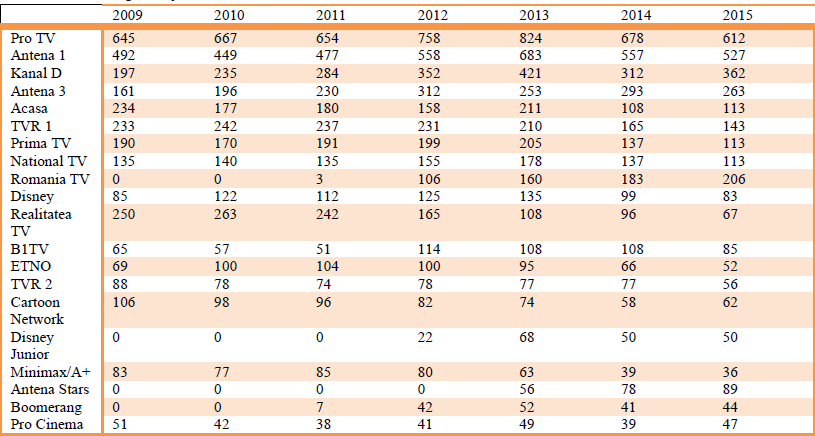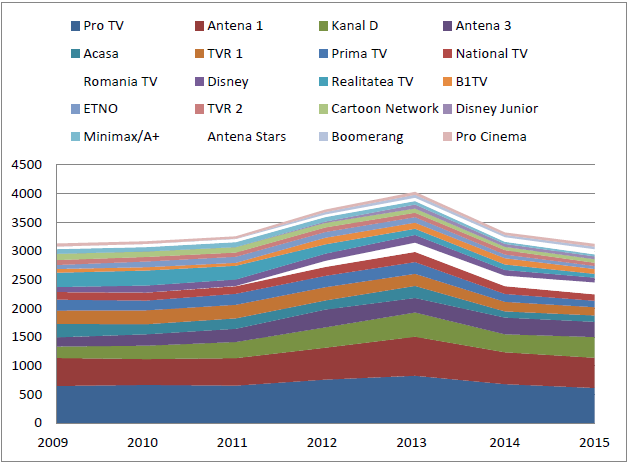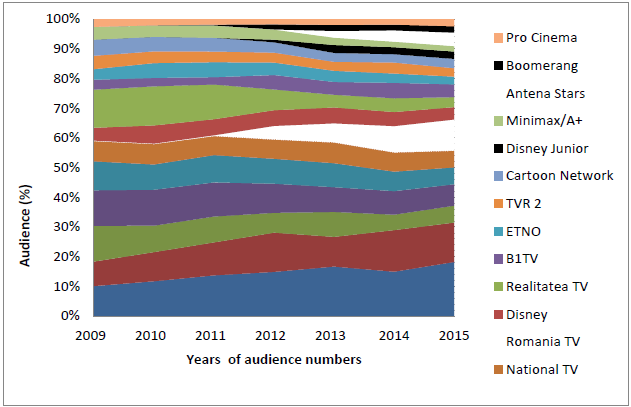Abstract
The concept of audience changed over the time depending on new theoretical and empirical axes׃ the sender approach and the receiver approach. The sender approach represents the studies conducted by media companies as a marketing activity. Those companies are interested in the public or audience as a market that buys their products and provides benefits for the shareholders. The receiver approach is mainly developed by public and ⁄or academic institutions to investigate the media consumption and their effects (on short or long term) on the public. Based on audience study for Romanian TV channels we will analyse the evolution of audience figures from the sender perspective. We used data from the National Audience Study. Conclusions will be drawn by applying niches theory. This analysis can explain the mutations we see on the media market, the transfer of the audience from an old medium to a newer one.
Keywords: Audience studymedia marketTV channelniches theory
Introduction
Past research on mass media highlighted the fact people choose media products being motivated by
the desire to satisfy different functions: advertisement, information, identity, social values, etc. One of
the first research in this field is Herzog’s (1944) who used formula
explain radio audience satisfaction. In the following years, researches have been conducted to explore
newspapers, television, mobile phones, electronic newsletters, etc. When a new medium is used for the
same purpose as an old medium, then the new medium is seen as an alternative of the other.
In this paper we will study TV audience and what happens when there are new comers on the TV
market, new TV channels that could ‘damage’ the established public. In these circumstances, the public
could migrate towards a new TV channel, could stay with the old ones, or could split preferences.
Thus, audience may choose between TV channels, according to the needs they satisfy.
The concept of audience changed over the time depending on new theoretical and empirical axes׃
the sender approach and the receiver approach.
The sender approach represents the studies conducted by media companies as a marketing activity.
Those companies are interested in the public or audience as a market that buys their products and
provides benefits for the shareholders.
The receiver approach is mainly developed by public and ⁄or academic institutions to investigate the
media consumption and their effects (on short or long term) on the public.
Based on audience study for Romanian TV channels we will analyze the evolution of audience
figures from the sender perspective. We used data from the National Audience Study. Data are
available on line at www.arma.org.ro and www.paginademedia.ro.
Conclusions will be drawn by applying niches theory. New TV channels emergence may or may not
create a competition with older, more established media, because audience may choose between them
by determining which one responds to their particular needs. The scientists try to explain this
competition using the ecological niche theory approach.
Niche Theory
Niche theory is a method used by Dimmik and Rothenbuhler (1984) to explain the competition in
the media environment and the consequences brought by a new medium.
According to the niche theory, the media environment could be seen as ecological spaces where the
biological populations compete one against the other for living resources (food, water, territory, living
conditions, etc.). According to the niche theory, the position of a medium is determined by the pattern
of resource usage that is its survival or growth in a competition environment. We can consider the
resource space as composed by microdimensions like gratifications, advertising, consumer time,
audience numbers, and consumer spending.
We will outline the niches’ indicators of coexistence, replacement or displacement of new TV
channels (Ramirez & all, 2008). Dimmik defined three niche indicators:
perceived to be. A high score suggests generalism, while a low score indicates specialism).
are finite).
efficient at fulfilling a specific gratification).
This analysis explained the mutations we see on the media market, the transfer of the audience from
an old medium to a newer one. More details of calculating these indicators can be found in Stefanescu
(2011).
Audience research in Romania
Speaking about audience research we make distinction between commercial
peoplemeter and the complex sociological inquiries that investigate audience under several aspects as –
attitudes evaluation, motivations and public satisfaction, life styles and cultural practice.
On the Romanian market there are or were a number of audiometry companies (AGB Data
Research, CSOP Tyler Nielsen SOFRES Mediametrie, TNS-AGB International, GfK, etc.) that made
quantitative studies on audience, but tried also qualitative methods, like the Media departments of
IMAS, CURS or IRSOP as well as academic research centers in communication studies like Center for
Media Studies and New Communication Technologies (University of Bucharest) and others.
The audience’s studies began with TV audience measurement that started in 1993. At the beginning,
the National Council of the Audiovisual (established 1992) ordered these studies (see www.sna.ro).
Until 1997 audience measurement used paper diaries filled by TV viewers from a selected cohort.
Starting 1998, the measurement is done by peoplemeters. In order to provide reliable data, the
measurement is controlled by a large association of media actors – The Romanian Association of
Audience Measurement (www.arma.ro). The present national study of audience uses a representative
panel of 1200 households to measure TV consumption and the socio-demographic profile of TV
viewers.
In the last decades, the
Social composition of the audience
Media effects, especially on children
Cultural consumption practices
Uses and gratification approach of media use
Analysis of specific groups (e.g. children of different ages, or couples of children and parents, etc.).
TV channels’ niches
In the period 2009-2015, four new TV stations were opened: two dedicated to the children (Disney
Junior-2012 and Boomerang 2009/2015) and other two Romanian channels, one for news (Romania
TV -2011) and one for entertainment (Antena Stars- 2013).
In Table 1, there are numbers representing the average daily audience of the main TV channels in
Romania (public and commercial), in a series of 7 years (2009-2015).

The table shows the two absolute audience leaders (ProTV and Antena 1). In order to get a relevant
picture, we eliminated the sport channels, and the music channels. The diagram in Fig.
surfaces of audience for every TV channel mentioned in the Table 1, starting with the two leaders, on
the bottom, and ending with the minor ones at the top of the picture. The actual audience trend is
decreasing for all the TV channels, but still the order is kept.
As an exception, the four new TV channels try to gain resources and their audience number
increased at the beginning, now they are stable.
In order to be more visible we eliminated from the diagram the two audience leaders that were not
disturbed by the new entries. But, if we look attentively the niches are ‘feeding’ with the others’
audience and narrow their surface.
With an areas diagram (Fig. 2), one could see the niches, the surfaces that the four new TV channels
are spreading. There are two thin black lines for the new children’s channels and two white consistent
areas representing Romania TV and Antena Stars.


Conclusions
Although in present days television is the main information channel in Romania, new media gains
the interest of younger and educated people, despite print media. The radio has a low but stable
audience and moved to digital. Dragan (2007) revealed that at family level people watch TV for
relaxation and fun, but at individual level media consumption is motivated by understanding society
and information. This suggests we could orient our future research on two analysis units: family and
individual.
From the perspective of niche theory, the utility of a medium to fulfil the needs of its users and to
give them gratification opportunities is vital to its survival and growth in a resource space.
As we noticed in the descripted analysis above, the niches exists and our research will be targeted on
the identification of consuming practices and gratifications offered by using old and/or new TV
channels. So, future analysis/surveys will be dedicated to explain the factors that determine the
audience dynamics.
References
- Dragan, I. (2007). Comunicarea. Paradigme si teorii, vol 1 si 2. Bucuresti: Rao.
- Dimmick, J., & Rothenbuhler, E. (1984). The Theory of the Niche: Quantifying Competition Among Media Industries. Journal of Communication, 34(1), 103–119.
- Herzog, H. ( 1944). Motivations and Gratifications of Daily Serial Listeners, Radio Research 1942-1943, eds. Paul Lazarsfeld and Frank Stanton( N. Y. , Duell, Sloan and Pierce, 1944) Ramirez, A., Dimmick, J., Feaster, J., & Lin, S. (2008). Revisiting interpersonal media competition: The gratification niches of instant messaging, e-mail, and the telephone. Communication Research, 35, 529-547. Stefanescu, P. (2007). La reconfiguration du marché des médias roumains. In Rogojinaru, A (coord), Comunicare si cultura organizationala-idei si practici in actualitate, Tritonic, Bucuresti.
- Stefanescu, P. (2011). New communication technologies competition and coexistence. Proceedings of ICEA-FAA Conference, 2011.
- www.paginademedia.ro www.arma.org.ro www.brat.ro
Copyright information

This work is licensed under a Creative Commons Attribution-NonCommercial-NoDerivatives 4.0 International License.
About this article
Publication Date
04 October 2016
Article Doi
eBook ISBN
978-1-80296-014-3
Publisher
Future Academy
Volume
15
Print ISBN (optional)
-
Edition Number
1st Edition
Pages
1-1115
Subjects
Communication, communication studies, social interaction, moral purpose of education, social purpose of education
Cite this article as:
Stefanescu, P. (2016). Audience Dynamics and Market Share Transfer. In A. Sandu, T. Ciulei, & A. Frunza (Eds.), Logos Universality Mentality Education Novelty, vol 15. European Proceedings of Social and Behavioural Sciences (pp. 951-956). Future Academy. https://doi.org/10.15405/epsbs.2016.09.118

